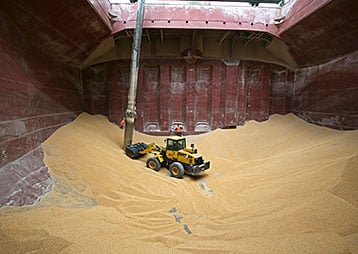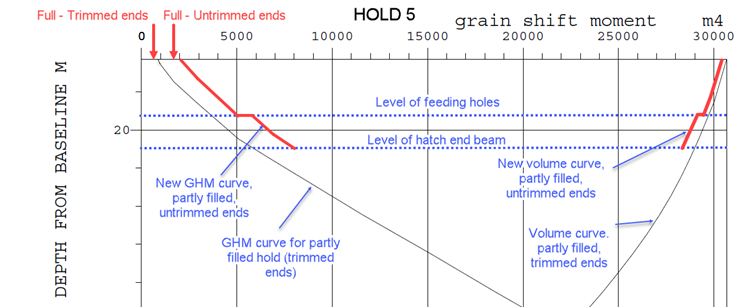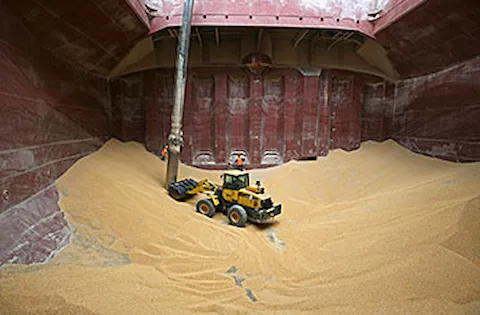Amendments to the International Code for the Safe Carriage of Grain in Bulk
Amendments to the International Code for the Safe Carriage of Grain in Bulk (“Grain Code”) have been adopted by IMO Resolution MSC.552(108). These amendments introduce requirements and guidance for a new filling type not covered by the existing code. Find out more about the amendments in this statutory news.
Relevant for ship owners and managers of bulk carriers as well as design offices, shipyards, suppliers and flag states.
Background to the amendments

Currently, the Grain Code offers three official loading patterns for grain in each cargo hold:
- Full hold, trimmed ends
- Full hold, untrimmed ends
- Partly filled hold
For a partly filled hold, the grain surface is assumed to be “trimmed” to an approximate even surface at any loading level, also when the hold is near full. This implies that the space underneath the deck, fore and aft of the hatch, socalled ends, must also be trimmed for levels inside the hatch perimeter. As a result, the grain must be manually shuffled up under the end girders to reduce the void. This is illustrated in figure 1.
Since trimming the ends is labour-intensive, it is not always carried out. When trimming is omitted in partly filled holds, the actual voids in the ends are larger than those assumed by following the current calculation method. As a result, the actual grain shifting moment will be larger than the calculated value.
Figure 1: Partly filled hold in way of the hatch opening, ends trimmed
(longitudinal view)
What is new?
To address this, a fourth permissible loading pattern has been introduced to the new Grain Code amendments:
- Partly filled hold, in way of the hatch opening, ends untrimmed
This means that if the final filling level of a cargo hold is inside the perimeters of the hatch coaming, measured from the lower level of the hatch end beams and upwards, the ends do not need to be trimmed. The grain surface shall form a natural slope from either the hatch end beam or from the feeding holes in the end girder, depending on the filling height (a 30-degree slope is assumed in the calculations). This is illustrated in the following figures:

Figure 2: Partly filled holds in way of the hatch opening, below feeding
holes, ends untrimmed (longitudinal view)

Figure 3: Partly filled holds in way of the hatch opening, above feeding
holes, ends untrimmed (longitudinal view)
For this new loading pattern, a new calculation must be made for grain shift moment and volume curves, listed from the level of the bottom of the end girder to the top of the hatch coaming – see the following figure:

Figure 4: Additional curves for grain shift moment and volume shall be made for each cargo hold (filling level on vertical axis; additional calculated
curves are shown in red) – these curves shall be included in the grain loading manual or in an addendum to this
Applicability
The Grain Code amendments enter into force 1 January 2026 and will be applicable to newbuildings with keel laid on or after this date. For existing ships, the amended Grain Code can also be applied to improve loading flexibility and demonstrate compliance with the new requirements. It is expected that there will be an increased attention on this loading pattern by inspectors in the larger grain exporting ports from 2026.
The need to implement such an update for existing ships will largely depend on the individual ship’s cargo capacity, the maximum draught, and the specific gravity of the type of grain typically carried. If a ship, when operating at its normal/ fixed grain trade, can consistently load all holds fully – with untrimmed ends – without exceeding the maximum loadline draught, or only rarely encounters a fully loaded condition where one hold is partial filled within the hatch, such an update may not be necessary.
It is also worth noting that trimming can still be performed for a partial filled hold – where the grain level is below the hatch coaming – if such a service is available in the port.
For ships already in operation, an addendum to the existing grain loading manual can be prepared and submitted to DNV for approval. This addendum must include the updated grain shift moment and volume curves – both graphically and in tabular form – as well as the loading condition(s) (departure and arrival), with at least one hold partly filled within the hatch coaming. The input data used for the calculation must be submitted either as a separate document or as an appendix to the addendum.
Alternatively, if the newbuilding yard or designer, whoever holds the original set of design information, is contracted tocarry out the updates, a complete version of the grain loading manual may be prepared instead of an addendum.
The vessel’s on-board loading computer shall also be updated and re-approved to incorporate the new grain and volume curves, as well as the revised load pattern option.
Recommendations
The Grain Code amendments enter into force 1 January 2026 and will be applicable to newbuildings with keel laid on or after this date, whereby the yard/designer will need to implement the additional curves in the grain loading manual and in the loading computer.
For ships constructed prior to 1 January 2026, but not yet delivered, it is recommended that the owner and yard understand the Grain Code amendments and implement the same set of standards to ensure safe operations.
For ships already in operation, an addendum to the existing grain loading manual can be prepared and submitted to DNV for approval if found relevant for the respective ship.
References
- Amendments to the International Code for the Safe Carriage of
Grain in Bulk (“Grain Code”), IMO Resolution MSC.552(108) - International Code for the Safe Carriage of Grain in Bulk, MSC 23(59)
Contact
- For customers:
DATE - Direct Access to Technical Experts via My Services on Veracity. - Otherwise:
Use our office locator to find the nearest DNV office.

